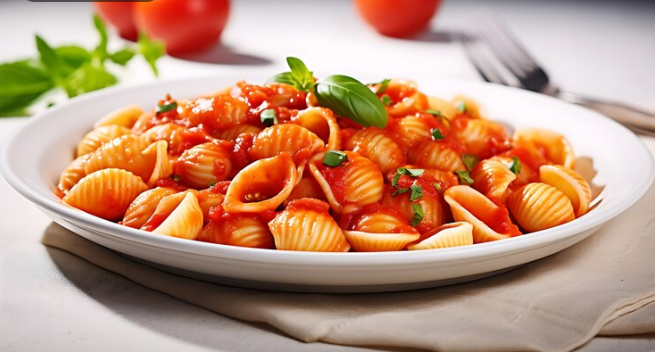Unveiling the Delights of Creamy Tomato Pasta
What is creamy tomato pasta called? Creamy tomato pasta is renowned for its rich texture and vibrant flavor, making it a global staple. This dish skillfully combines the tanginess of tomatoes with creamy richness. Herbs and spices enhance its depth further. Known as « Rosé Pasta » and « Pasta ala Vodka » in different areas, it showcases its adaptability and broad appeal. This introduction highlights the dish’s popularity and its various global interpretations, focusing on its simplicity and widespread culinary enjoyment. It sets the stage for a deep dive into the world of creamy tomato pasta, inviting readers to explore its richness and diversity.
The Basics of Creamy Tomato Pasta
Creamy tomato pasta is a versatile and beloved dish that combines the acidic zest of tomatoes with the rich smoothness of cream to create a luscious and inviting sauce. This sauce is typically paired with pasta, serving as a hearty base that clings to every noodle, enriching every bite with its robust flavors.
What is Creamy Tomato Pasta?
At its core, creamy tomato pasta is a fusion of tomato sauce and cream. The sauce begins with a tomato base often made from cooked down tomatoes or a purée—which is then mellowed and enriched with cream. This combination results in a sauce that is smoother and richer than traditional marinara, yet still retains the bright, vibrant tomato flavor. The addition of garlic, onions, and various herbs like basil or oregano enhances the complexity of the dish, making it a perennial favorite in many culinary traditions.
Definition and Basic Ingredients
The essential ingredients for creamy tomato pasta include:
- Tomatoes: Fresh, canned, or in paste form, providing the fundamental acidic base.
- Cream: Heavy, light, or half-and-half, used to temper the acidity of the tomatoes and add a creamy texture.
- Garlic and Onions: For foundational flavor.
- Herbs: Such as basil, oregano, or parsley, to add freshness and aroma.
- Seasonings: Salt, pepper, and sometimes red pepper flakes for a hint of spice.
Common Names
Depending on the region and specific variations, creamy tomato pasta may go by several names. The most common include:
- Pink Sauce: Suggestive of the color that results from mixing white cream with red tomato sauce.
- Rosé Pasta: A nod to the Rosé wine, this name reflects the light, refreshing nature of the sauce, akin to the popular beverage.
- Tomato Cream Sauce: A straightforward name that describes the primary components of the dish.
Each of these names highlights a different aspect of the sauce, from its appealing color to its luxurious texture, underscoring the global love and adaptability of this simple yet satisfying meal. Whether served over spaghetti, fettuccine, or penne, creamy tomato pasta remains a cherished dish in households and restaurants alike, proving that good food does not need to be complicated.
Historical Background
Creamy tomato pasta, with its rich and inviting sauce, is a relatively modern creation in the culinary world, yet its roots are deeply embedded in the rich history of tomato sauces, which have evolved over centuries.
Origins and Evolution of Creamy Tomato Sauce
The journey of tomato sauces begins with the introduction of the tomato to Europe from the Americas in the 16th century. Initially met with suspicion and deemed unfit for consumption, tomatoes slowly gained culinary acceptance. It wasn’t until the late 17th to 18th century that tomatoes began to feature prominently in the cooking pots of Spain and Italy, where they were transformed into the first simple tomato sauces.
These early sauces laid the groundwork for what would become a cornerstone of Italian cuisine. As tomatoes gained popularity, they became a staple in the Mediterranean diet, leading to the development of various regional sauces that are celebrated globally today.
Historical Origins of Tomato Sauces
The first recorded tomato sauce recipes appeared in Italian cookbooks in the late 17th century. These recipes were simple, often consisting only of tomatoes cooked down with herbs and sometimes onion or garlic. Over time, as culinary techniques evolved and tomatoes became a more central ingredient in Mediterranean cooking, these sauces became more complex and integral to many traditional dishes.
Development into Creamy Tomato Variations
- Creamy tomato sauces began with dairy in France or Italy, blending European dairy techniques with Italian tomato sauces.
- Incorporating cream made sauces richer and smoother, likely starting in the 19th or early 20th century.
- Today’s global versions include Russian « Pasta alla Vodka » and Indian spiced variations, showcasing ongoing culinary evolution.
- This rich history connects creamy tomato sauces to centuries of food innovation across continents.
Culinary Techniques
Mastering the art of creamy tomato pasta requires a blend of simple cooking techniques and a keen sense for balancing flavors and textures. This section provides a step-by-step guide to crafting the perfect creamy tomato pasta, along with tips to ensure every dish is as delightful as it is satisfying.
Preparing the Perfect Creamy Tomato Pasta
Creating creamy tomato pasta involves a few key steps that transform basic ingredients into a sumptuous meal:
- Sauté the Aromatics: Begin by heating olive oil in a large skillet over medium heat. Add finely chopped onions and minced garlic, cooking until they are soft and translucent. This provides a flavorful foundation for the sauce.
- Cook the Tomatoes: Add crushed tomatoes to the skillet. If using fresh tomatoes, peel and deseed them before chopping. Simmer the tomatoes with the onions and garlic, allowing the flavors to meld. Season with salt, pepper, and optional red pepper flakes for a bit of heat.
- Add Cream: Once the tomato mixture has thickened slightly, reduce the heat and stir in the cream. For a richer sauce, use heavy cream; for a lighter version, half-and-half or a splash of milk will do. Allow the sauce to simmer gently, which thickens the cream without curdling.
- Season and Herbs: Adjust seasoning to taste, adding more salt or pepper as needed. Stir in fresh or dried herbs like basil or oregano towards the end of cooking to preserve their vibrant flavor.
- Combine with Pasta: Cook your choice of pasta in a pot of boiling salted water until al dente. Drain the pasta, reserving a cup of the pasta water. Toss the pasta directly in the sauce, adding reserved pasta water as needed to achieve the desired consistency. This helps the sauce adhere to the pasta better.
- Final Touches: Give the dish a final taste and adjust the seasonings if necessary. Serve hot, garnished with grated Parmesan cheese and additional fresh herbs.
Tips for Achieving the Perfect Texture and Flavor Balance
- Use Quality Ingredients: The simplicity of creamy tomato pasta means that every ingredient needs to shine. Use high-quality tomatoes and fresh herbs for the best flavor.
- Simmer Slowly: Letting the sauce simmer gently allows the flavors to develop fully without the risk of the dairy separating or curdling.
- Balance Acidity: If the sauce is too acidic, a pinch of sugar or a splash of cream can help balance the flavors. Conversely, a squeeze of fresh lemon juice can brighten the dish if it feels too rich.
- Texture is Key: The sauce should be creamy but not overly thick. Use pasta water to adjust the consistency and ensure the sauce coats the pasta evenly.
By following these steps and tips, anyone can create a deliciously creamy tomato pasta that is sure to impress.
Variations and Adaptations
Creamy tomato pasta is not just a dish but a canvas, allowing various cultures to imprint their unique flavors and culinary traditions. This versatility has led to a myriad of regional variations, each adapting the basic creamy tomato pasta recipe to local tastes and ingredients.
Regional Variations of Creamy Tomato Pasta
- Italy: Pasta Rosa – In Italy, creamy tomato pasta often incorporates ricotta or mascarpone, adding a distinctly Italian twist to the creaminess of the sauce. Basil and oregano are the herbs of choice, enhancing the dish with fresh, aromatic flavors.
- United States: Tomato Basil Cream Pasta – This American version usually includes a generous amount of garlic and uses heavy cream for a richer sauce. It’s often served with meatballs or grilled chicken to make it a more hearty meal.
- India: Masala Pasta – Indian adaptations might include a touch of garam masala or curry powder, introducing a warm, spicy element to the creamy tomato sauce. Coconut milk is sometimes used instead of dairy cream, catering to the lactose-intolerant and vegan populations.
- Russia: Pasta Alla Vodka – Though popular in many countries, Pasta Alla Vodka is said to have Russian origins. Vodka is added to the tomato cream sauce to enhance the flavors and help emulsify the sauce, giving it a smooth, silky texture.
Specific Regional Ingredients or Twists
Spain: Chorizo and Seafood
- In Spain’s coastal areas, creamy tomato pasta often includes chorizo and seafood like prawns or scallops, showcasing the nation’s seafood tradition.
Greece: Feta and Olives
- Greek variations feature crumbled feta and black olives, providing a salty contrast to the sweet, creamy sauce.
Mexico: Chipotle Cream Pasta
- Mexican adaptations use chipotle peppers in adobo sauce, adding smoky heat that enhances the sweet tomatoes and rich cream.
These regional adaptations underscore creamy tomato pasta’s worldwide appeal and its versatility in blending local flavors.
Nutritional Information
Creamy tomato pasta is a delightful dish, but like many comfort foods, it comes with considerations regarding its nutritional content. This section explores the health aspects of creamy tomato pasta, providing insights into its caloric content, nutritional breakdown, and dietary adaptations to accommodate various health needs.
Health and Nutritional Considerations
Creamy tomato pasta can vary widely in nutritional value depending on the ingredients used. A typical serving of this dish, primarily made with heavy cream and white pasta, can be quite calorie-dense. The main components contribute the following:
- Calories: A standard serving can contain between 400-600 calories, largely from the pasta and cream.
- Fats: High in saturated fats due to the cream; approximately 20-30 grams per serving.
- Carbohydrates: Primarily from pasta; roughly 70-90 grams per serving.
- Proteins: Modest protein content, around 10-15 grams per serving, which can increase if served with meat or cheese.
- Vitamins and Minerals: Tomatoes provide vitamin C and potassium, while dairy adds calcium and vitamin D.
Nutritional Breakdown
The sauce’s tomato base offers antioxidants such as lycopene, which has been linked to numerous health benefits, including reduced risk of heart disease and cancer. However, the high fat and calorie content from the cream and pasta might make it less suitable for those on calorie-restricted diets.
Dietary Adaptations
To make creamy tomato pasta more accessible to those with dietary restrictions, several adaptations can be considered:
- Vegan: Substitute dairy cream with plant-based alternatives like cashew cream or coconut milk. These options lower the dish’s cholesterol and saturated fat content.
- Gluten-Free: Use gluten-free pasta made from rice, quinoa, or corn instead of traditional wheat pasta.
- Low-Calorie: Opt for light cream or skim milk instead of full-fat cream, and increase the proportion of tomatoes and vegetables to boost fiber and reduce calorie density.
These adaptations not only make creamy tomato pasta healthier but also more inclusive, allowing those with specific dietary needs to enjoy this classic dish without compromise.
Serving and Pairing Suggestions
Creamy tomato pasta, with its rich and inviting flavors, serves as a versatile centerpiece for many meals. This section outlines how to serve and pair the dish to enhance its enjoyment, including suitable side dishes, wine pairings, and serving suggestions for various occasions.
How to Serve and Pair Creamy Tomato Pasta
When serving creamy tomato pasta, presentation and pairing can elevate the experience:
- Presentation: Garnish with fresh basil or parsley to add a pop of color and freshness. A sprinkle of grated Parmesan or pecorino cheese can add a savory touch that complements the creamy sauce.
Suitable Side Dishes
Complementing creamy tomato pasta with appropriate side dishes can create a balanced meal:
- Garlic Bread: The crisp texture and aromatic flavor of garlic bread is perfect for sopping up extra sauce.
- Green Salad: A simple salad dressed with vinaigrette offers a refreshing contrast to the richness of the pasta.
- Steamed Vegetables: Lightly steamed seasonal vegetables like asparagus, broccoli, or zucchini add a healthy and colorful component to the meal.
Wine Pairings
Selecting the right wine can enhance the flavors of the dish:
- White Wines: A crisp Chardonnay or Pinot Grigio pairs well by cutting through the richness of the cream with acidity.
- Light Red Wines: A light-bodied red like Pinot Noir can complement the tomato base without overwhelming the dish.
Serving Suggestions for Different Occasions
Creamy tomato pasta is adaptable for various settings:
- Casual Dining: Serve in a large, communal bowl for family-style dining, encouraging a shared meal experience.
- Romantic Dinner: Plate individually for a more intimate presentation, pairing with a glass of wine and dim lighting.
- Party Food: Offer as part of a pasta bar with various sauces and toppings, allowing guests to customize their plates.
By considering these serving and pairing suggestions, creamy tomato pasta can be adapted to suit any meal, from a casual lunch to an elegant dinner party, ensuring it is enjoyed at its best.
Frequently Asked Questions
Creamy tomato pasta, while straightforward in its basic preparation, often prompts questions about pasta types, make-ahead tips, and storage. Here are answers to some of the most commonly asked questions.
What types of pasta work best with creamy tomato sauce?
- The best types of pasta for creamy tomato sauce are those that can hold the sauce well. Options like penne, rigatoni, or fusilli are ideal because their shapes allow the sauce to cling to the pasta, ensuring each bite is flavorful. Flat noodles like fettuccine or tagliatelle also work well as they provide a broad surface for the creamy sauce to adhere.
Can creamy tomato pasta be made ahead of time?
- Yes, creamy tomato pasta can be prepared ahead of time, making it a convenient option for meal planning. To preserve the best texture and flavor, cook the pasta until it’s just under al dente and mix it with a slightly thinner version of the sauce. This way, when reheated, the pasta finishes cooking in the sauce, absorbing flavors without becoming too soft.
How to store and reheat leftovers?
- Store leftovers in an airtight container in the refrigerator for up to three days. To reheat, place the pasta over low heat on the stove, adding a splash of cream or milk to help the sauce regain its creamy consistency. Stir gently until heated through. Avoid using high heat or microwaving too long as these can cause the sauce to separate and the pasta to become overly soft.
Internal Linking Strategy for Creamy Tomato Pasta Article
- « Tomato cream sauce »: Link to an article about making tomato cream sauce. Embed the link in your article at the mention of the sauce’s preparation to provide readers with a detailed recipe.
Link: Tomato Cream Sauce for Pasta - « Pasta ala Vodka »: Since this is a variation of creamy tomato pasta, link to an article discussing this dish. Embed the link where you discuss variations of creamy tomato pasta to show an example of how the basic recipe can be modified.
Link: Pasta ala Vodka – Note: The link seems mislabeled and may need checking for relevancy. - « Quick tomato pasta »: For readers looking for a simpler or quicker alternative, link to an article on quick tomato pasta recipes. Embed this link when discussing easy pasta recipes for busy weeknights.
Link: Not directly available from the current list; you might consider creating or locating a relevant article. - « Creamy sauce recipes »: Link to a collection of recipes featuring creamy sauces, which can be beneficial for readers interested in exploring other dishes with similar sauces. Embed the link when you mention exploring other creamy dishes.
Link: Not directly available from the current list; consider creating or locating a relevant section on your site.
Suggested External Resources for Further Reading
- Wikipedia on Tomato Sauce
- Link: Tomato Sauce – Wikipedia
- Embed in Phrase: « Historical origins of tomato sauces »
This link provides a comprehensive overview of the history and variations of tomato sauce, which can enhance understanding of its global culinary impact.
- The Story Behind The Sauce: Marinara – Paesana
- Link: The Story Behind The Sauce: Marinara
- Embed in Phrase: « evolution of creamy tomato sauce » This article explores the history of Marinara sauce, detailing its origins and evolution in Italian cooking, which parallels the development of creamy tomato sauces.
- Types of Pasta Sauces: Ingredients, Differences, & More – WebstaurantStore
- Link: Types of Pasta Sauces
- Embed in Phrase: « variations of creamy tomato pasta » This resource provides a detailed look at various pasta sauces, helping readers understand the different ingredients and types beyond creamy tomato sauce.



